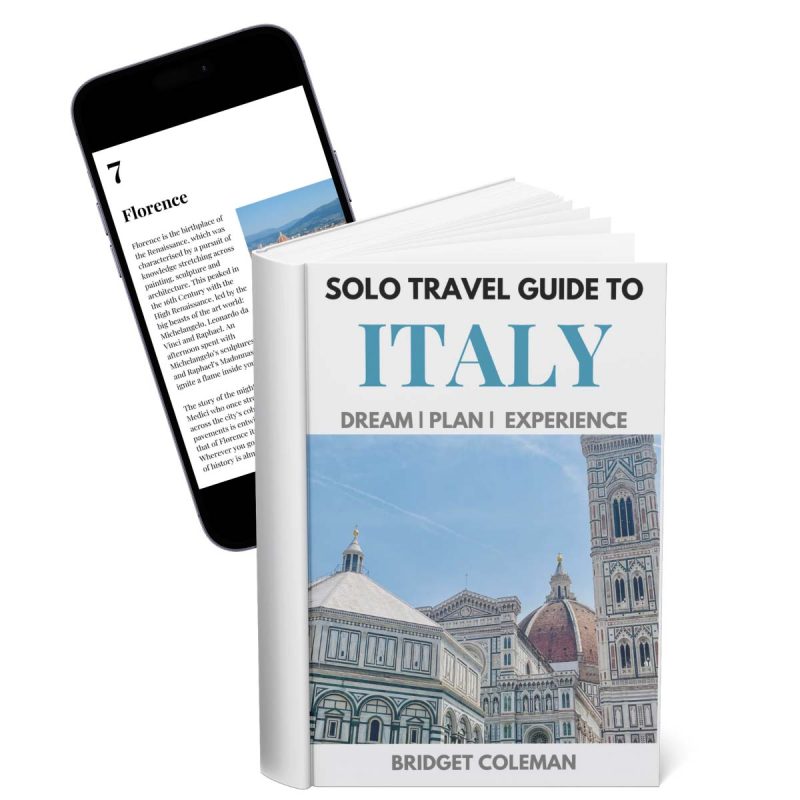Florence is the birthplace of the Italian Renaissance and it all began with sculpture. But what are statues in Florence you cannot miss in this all-you-can-eat artistic buffet of a city?
Some tough choices were needed but I’ve whittled this list down to my top 20 sculptures in Florence, Italy.
Many of these Florence statues are world-famous. Others are less well-known. But all of them are worthy of your precious few days in Florence.
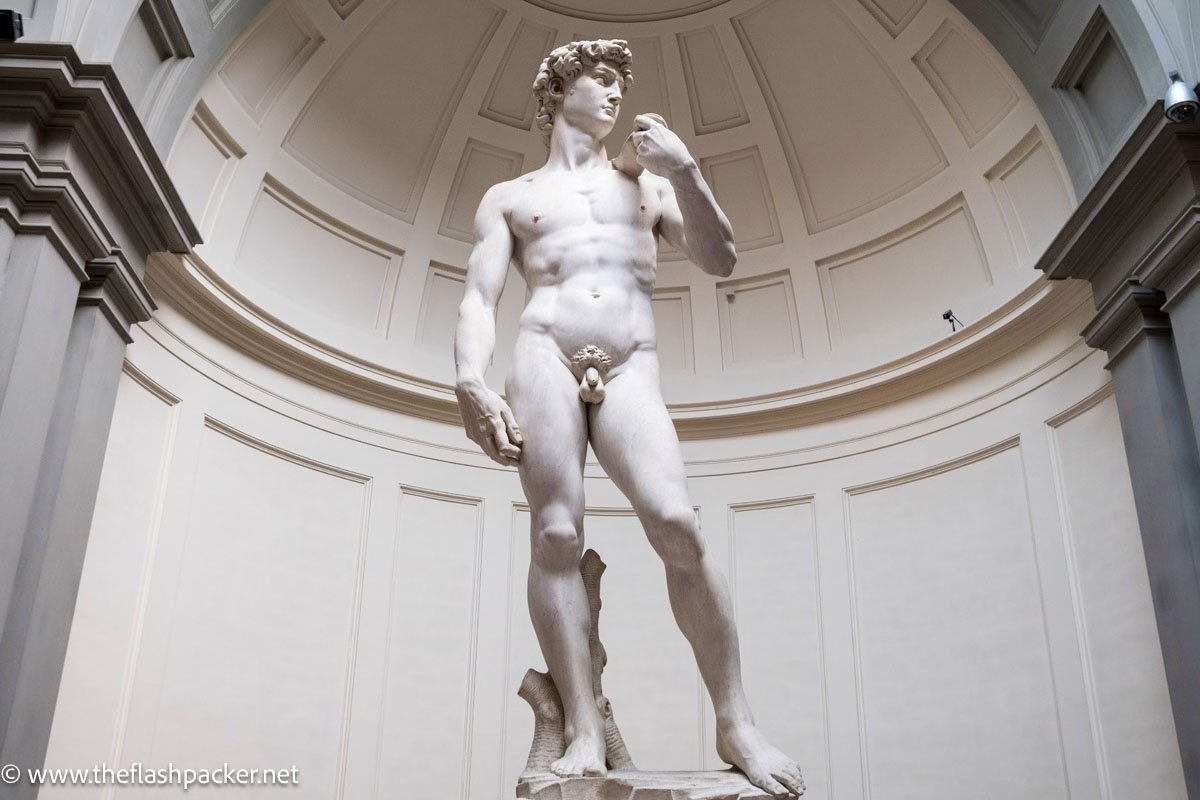
Some articles on this website contain affiliate links. This means that I may earn a small commission if you make a purchase through these links. As an Amazon Associate, I earn from qualifying purchases. Read the full disclosure here.
I’VE WRITTEN THIS ITALY SOLO TRAVEL GUIDE!
A 100+ page ebook to inspire and equip solo travellers with the confidence and knowledge to explore Italy independently
- Plan Your Trip – with curated itineraries, budgeting and how to get around
- Explore Awesome Destinations – guides to the must-see cities of Rome, Florence, Venice and Naples
- Stay Safe as a Solo Traveller – practical safety advice, empowering you to confidently navigate Italy and avoid common pitfalls
- Enjoy Eating Out in Italy – essential tried-and-tested solo dining tips
Statues in Florence’s Orsanmichele Church
Orsanmichele is considered to be the place where the Italian Renaissance began.
Built as a grain market in 1337, it was converted into a church for Florence’s powerful guilds at the turn of the 15th Century. Thus, Orsanmichele had both a secular and spiritual function.
Florence’s merchants and guilds commissioned statues in the late 14th Century to fill the church’s fourteen exterior niches. Today, these niches are occupied by copies.
With the exception of Donatello’s St. George in the Bargello Museum, the original sculptures are housed in the small museum belonging to the church.
Address: Via dell’Arte della Lana, Florence
Opening hours: Check here for current opening hours.
Entrance fee applies. Your timed ticket includes admission to the church and the museum.
Visiting the museum at Orsanmichele is a journey through Florentine sculptural history. I could have easily included all of its statues, but here are a few of my favourites.
Quattro Santi Coronati (Nanni di Banco)
Formerly occupying the niche of the guild of stonemasons and carpenters, this marble sculpture dates from the early 15th Century. It depicts four early Christian sculptors who were martyred by the Roman Emperor Diocletian for refusing to create pagan gods.
They look like they are having a debate about the wisdom of their fatal decision.
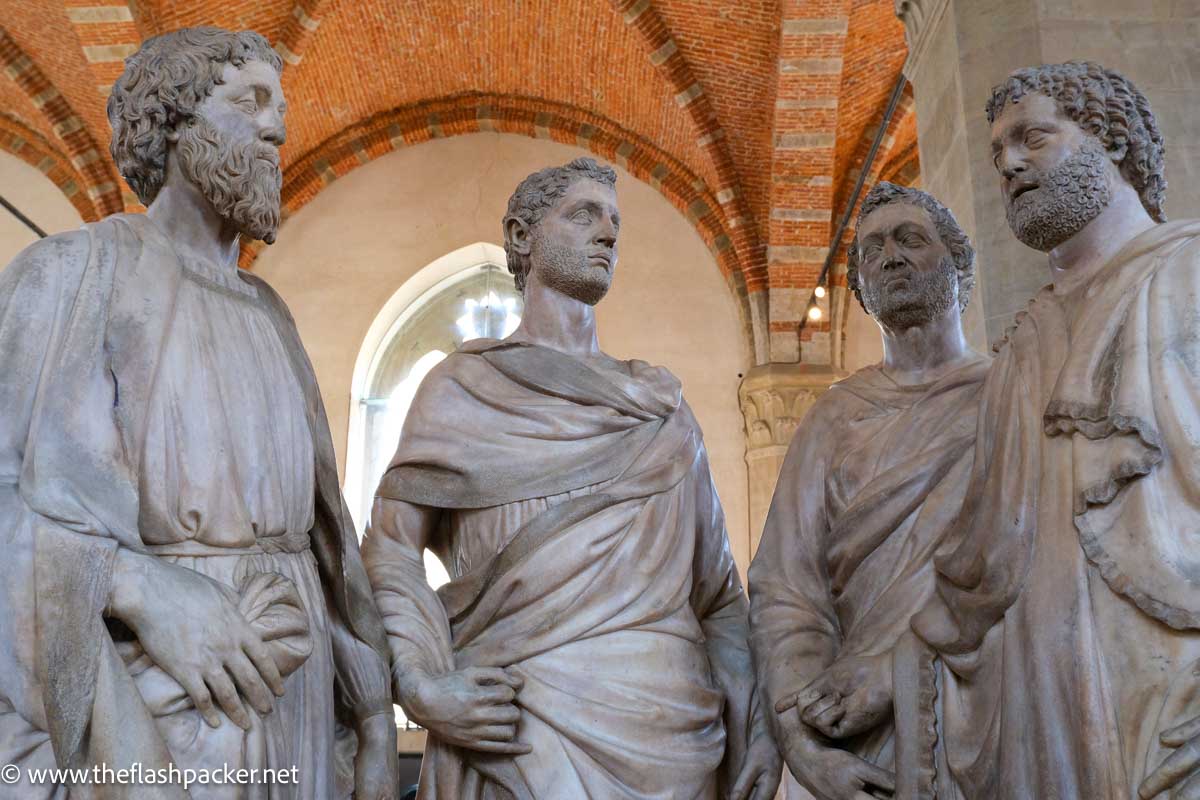
St. Mark (Donatello)
Created around the same time as Nanni di Banco’s sculpture, Donatello’s arresting evangelist cradles his gospel whilst gazing out to the middle distance. His subtle contrapposto was the first seen in sculpture for 1,000 years and he resembles Classical Greek and Roman statues.
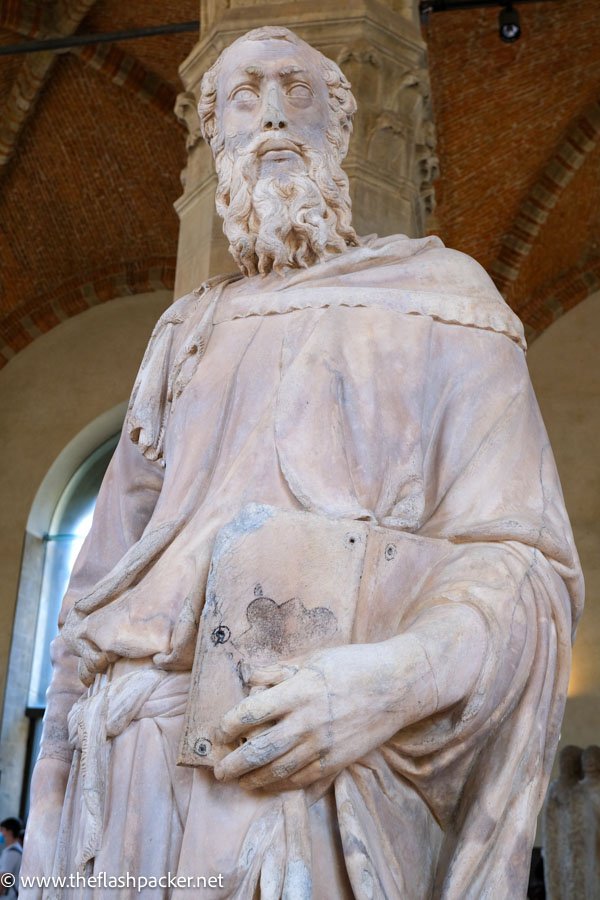
This statue once filled the niche of linen workers. A clue is the pillow on which St. Mark stands.
Doubting St. Thomas (Andrea del Verrocchio)
Commissioned by the Tribunale di Mercanzia (merchants), this bronze statue depicts Thomas’s disbelief at seeing the risen Christ. Thomas is agitated whilst Christ is serene, almost regal.
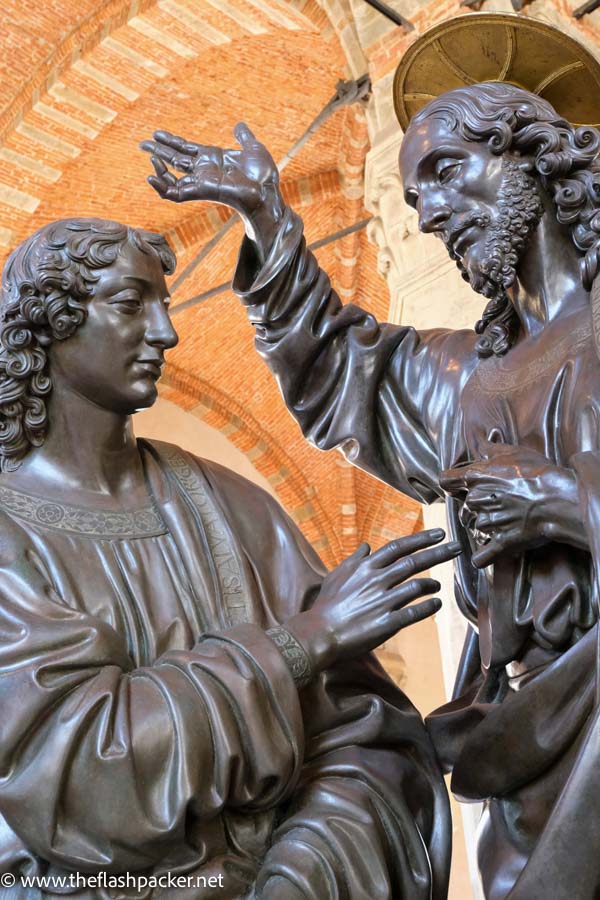
Sculptures in The Bargello Museum
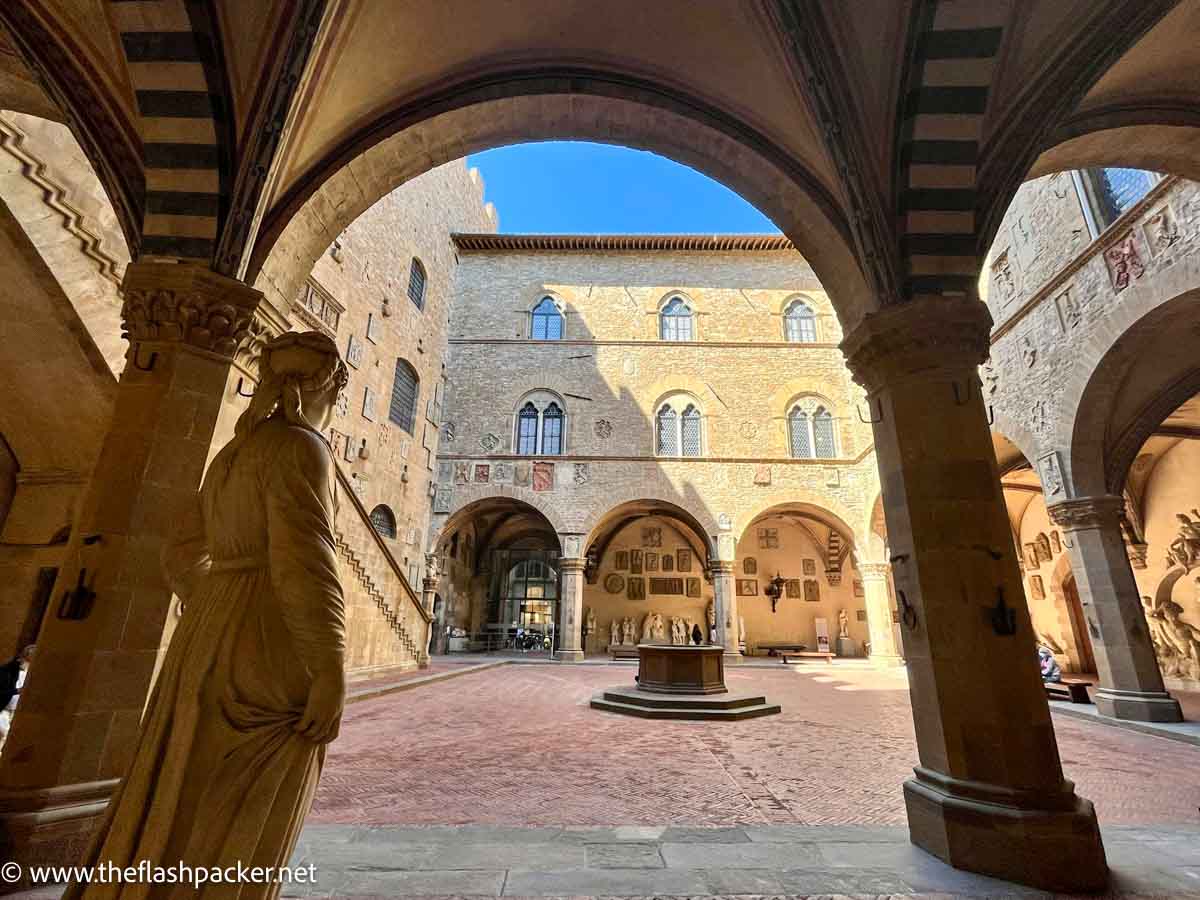
Visitors flock to the Uffizi Galleries to gaze at Giottos and to be bowled over by Botticellis. However, a fraction of these will step across the threshold of the Palazzo del Bargello.
This is a massive missed opportunity.
Think of the Bargello as the sculptural equivalent of the Uffizi. Housed in a rustic former palazzo that resembles a mini Palazzo Vecchio, its collection of statues spans 150+ years of Florence’s artistic heyday.
The lack of crowds and air of tranquillity only add to its appeal.
Address: Via del Proconsolo 4, Florence
Opening hours: Check here for current opening hours
Entrance fee applies
Baptistery Door Competition Entries (Lorenzo Ghiberti and Filippo Brunelleschi)
Renaissance sculpture in Florence was given a turbo boost in 1401 when there was a competition to design the doors of the city’s new Baptistery. Lorenzo Ghiberti was victorious and established a workshop that trained many famous Florentine artists and sculptors.
Thanks to enthusiastic patronage by the state and wealthy citizens, sculpture increasingly found a place in the city centre and in the homes of those who could afford it.
What we see here is the winning entry (Ghiberti) and the runner-up (Brunelleschi) in the competition to create bronze doors for Florence’s Baptistery. The artists’ brief was to depict the sacrifice of Isaac (Genesis 22).
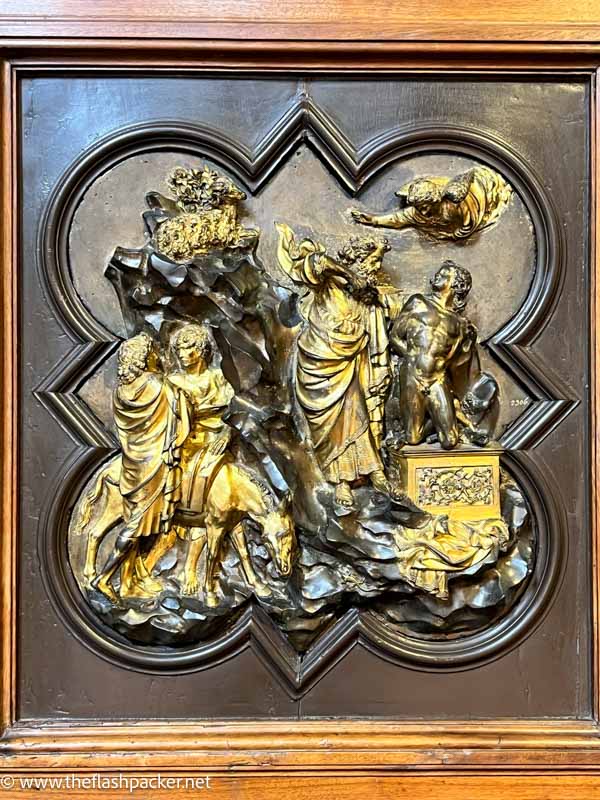
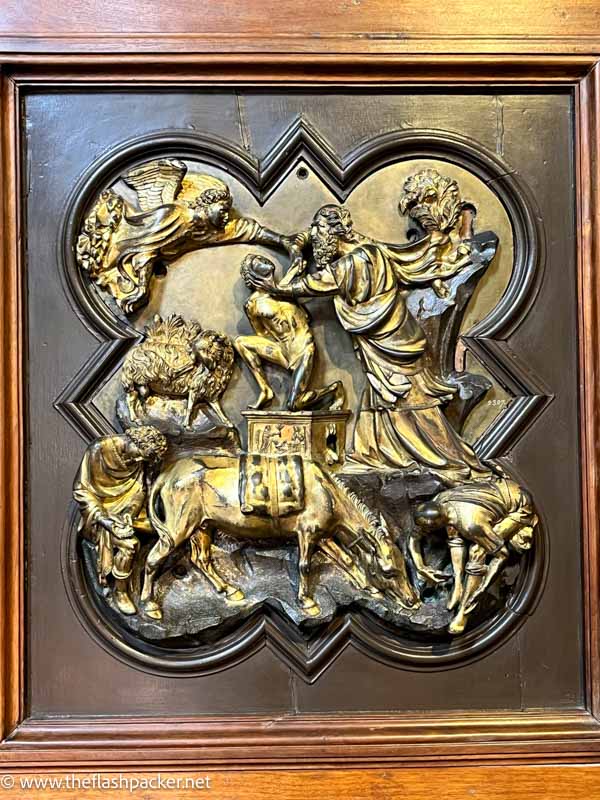
Ghiberti created the doors of the north entrance of the Baptistery (1403 – 1424) as well as a second set of doors (1425 – 1452). More about these later.
Although Brunelleschi was beaten by his rival, all was not lost. He went on to create the iconic dome of Florence Cathedral (Duomo).
St. George (Donatello)
Donato di Niccolò di Betto Bardi, better known as Donatello, was a graduate of Ghiberti’s workshop and revolutionised sculpture.
He carved this marble statue of St. George around 1417, and it once graced an exterior niche of the Orsanmichele Church (you can see a copy there today). It is said to be the first free-standing statue of Renaissance sculpture.
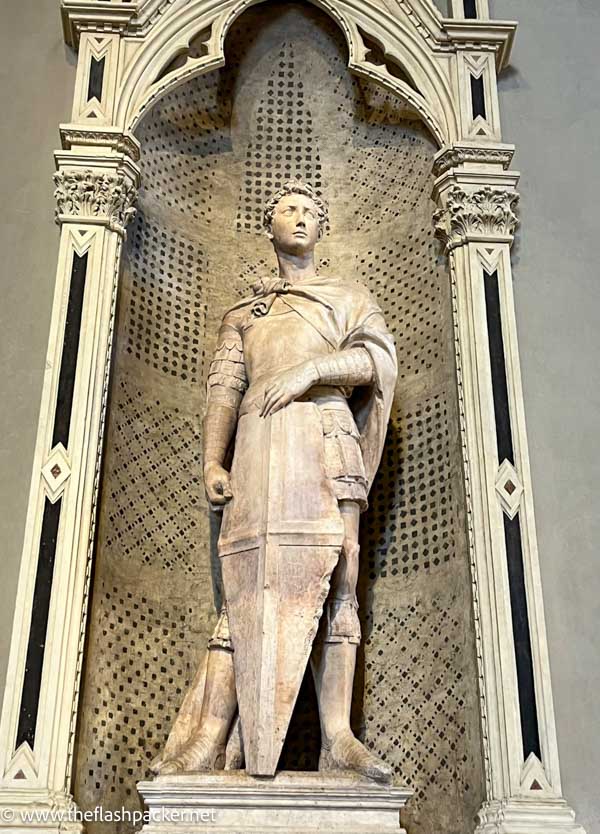
You may look at him and think that he is just a knight. But linger longer and you’ll pick up the artist’s attention to realism.
This is typified by the saint’s calm yet determined expression, his clothing and his natural pose. It is a far cry from the rigid representation of sculpture from medieval times.
David (Donatello)
Donatello sculpted this bronze David between 1435 and 1440. It was the first freestanding male nude that Europe had seen in a thousand years.
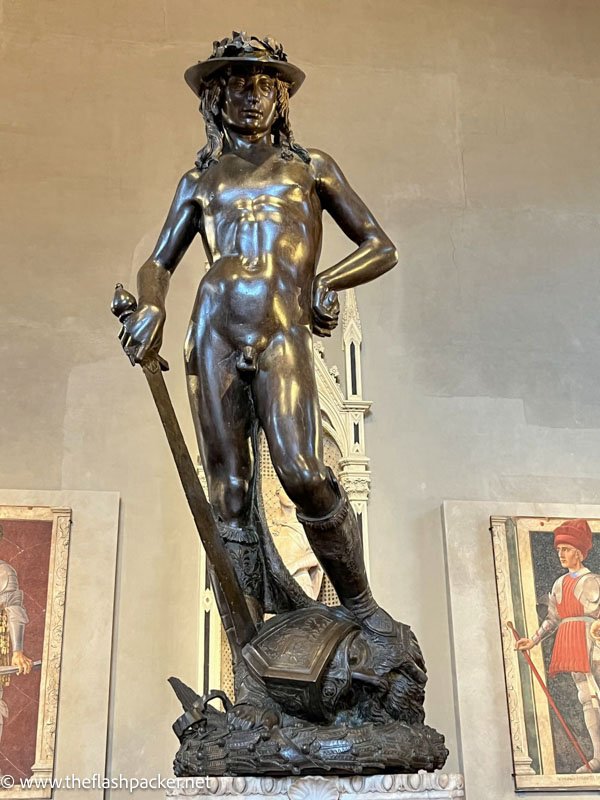
Undoubtedly, this sculpture would have influenced a young Michelangelo. This statue of David once stood in the Medici Palace where Michelangelo learnt his craft.
Bacchus (Michelangelo Buonarroti)
This statue of Bacchus, the pagan god of wine, was Michelangelo’s first major commission, sculpted around 1496 when he was only 21.
At that time, Florence was dominated by the fire-and-brimstone-preaching Savonarola. Michelangelo had fled to Rome, and this sensual sculpture can be viewed as sticking two fingers up at the monk.
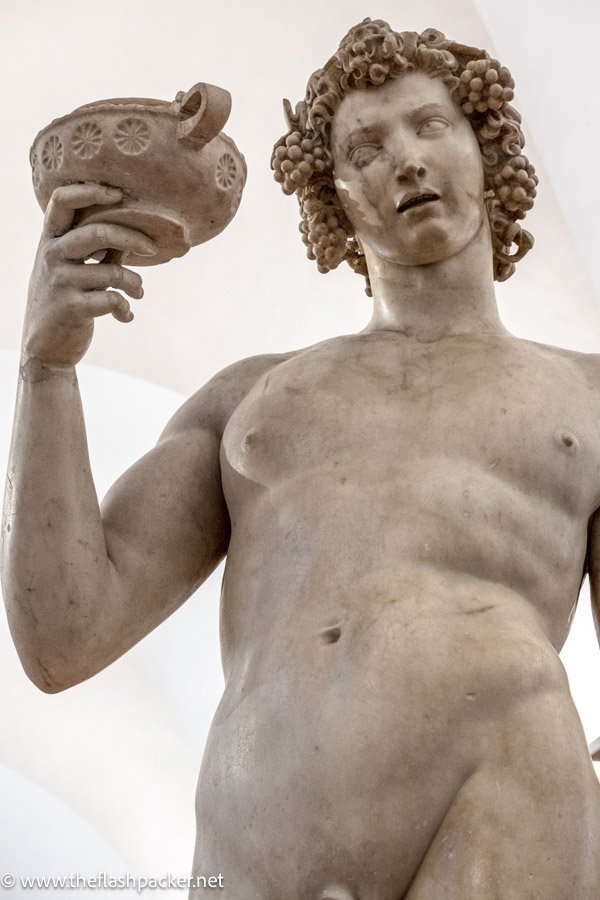
A naked and debauched Bacchus, who has a gaping mouth and sagging flesh, raises a cup of wine to his lips. This sculpture was not a hit with Cardinal Raffaele Riario, who commissioned it.
Brutus (Michelangelo Buonarroti)
We now fast forward to 1540 and the second of my pick of sculptures in Florence by Michelangelo. This time, he created a sculpture in a more classical style.
I love the duality of this bust of Brutus. Viewing it from the front – the right side of his face – Brutus looks heroic. But look at his face full-on and he appears sinister and sneering.
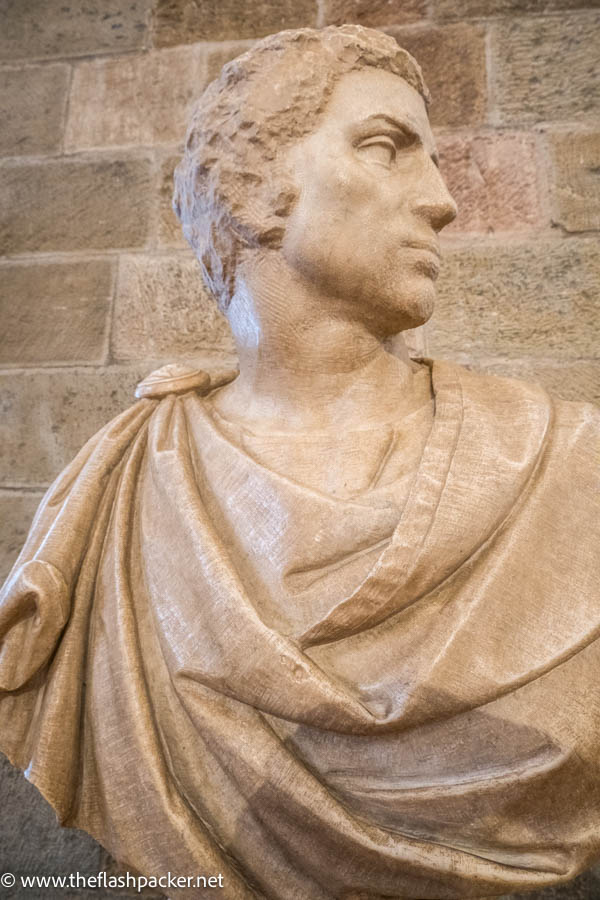
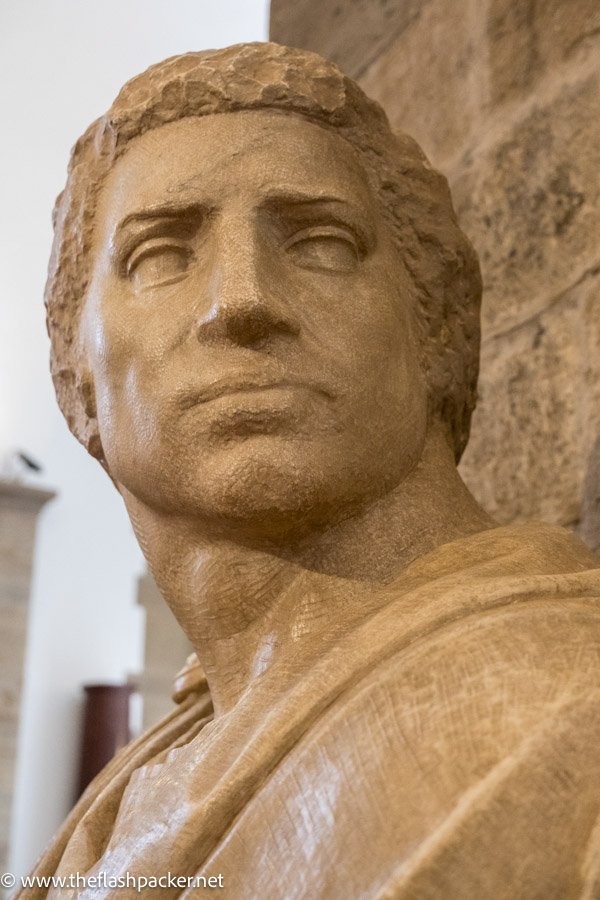
Brutus was famously one of the assassins of Julius Caesar and a conflicted individual. Although Caesar was his friend and mentor, he had become an unbearable dictator who needed to be taken out of the picture.
This internal conflict is ably represented in this Michelangelo sculpture.
Flying Mercury (Giambologna)
The Flemish-born Giambologna, also known as Jean de Boulogne and Giovanni da Bologna, was the last significant Italian Renaissance sculptor.
Familiar to many as the Interflora logo, his Mercury is a god on the move. Frozen in mid-stride, he leans forward, balancing on the breath of a Zephyr.
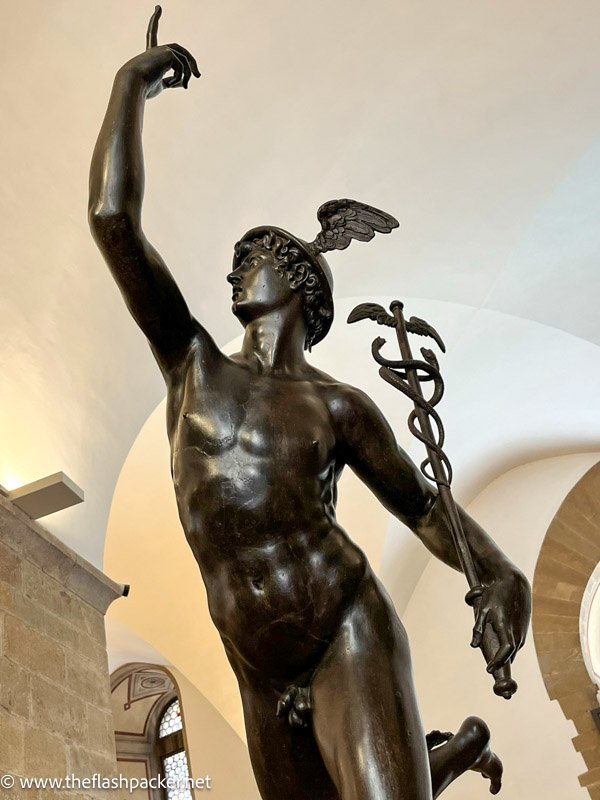
Sculpted in 1580, this sculpture graced Villa Medici for 200 years.
Sculptures in the Accademia, Florence
Even if you are only spending one day in Florence, don’t dump the Galleria dell’Accademia di Firenze from your itinerary. Known simply as the Accademia, this art gallery is world-famous as the home of Michelangelo’s sculpture of David.
But the giant-slayer isn’t the only reason for visiting the Accademia. Equally compelling are Michelangelo’s unfinished works, known collectively as the Prisoners or Slaves.
Address: Via Ricasoli 58/60, Florence
Opening hours: Check here for current opening hours
Entrance fee applies. I highly recommend booking your ticket in advance
David (Michelangelo Buonarroti)
Michelangelo’s David at the Accademia Gallery is easily the most famous statue in Florence, if not the world. A symbol of both the Renaissance and the city, David is crafted from gleaming white marble and stands 14 feet high. He rarely disappoints.
David encapsulates the spirit of Renaissance Man. He is a symbol of divine victory over evil and represents the optimism and humanism of the early 16th Century.
This statue is impressive from every angle. But much like Michelangelo’s bust of Brutus, I think there’s a duality here.
Viewed from the front, he is relaxed and confident yet alert as he sizes up his enemy. Swivel to the side of the sculpture and gaze into his face, and he appears more unsure.
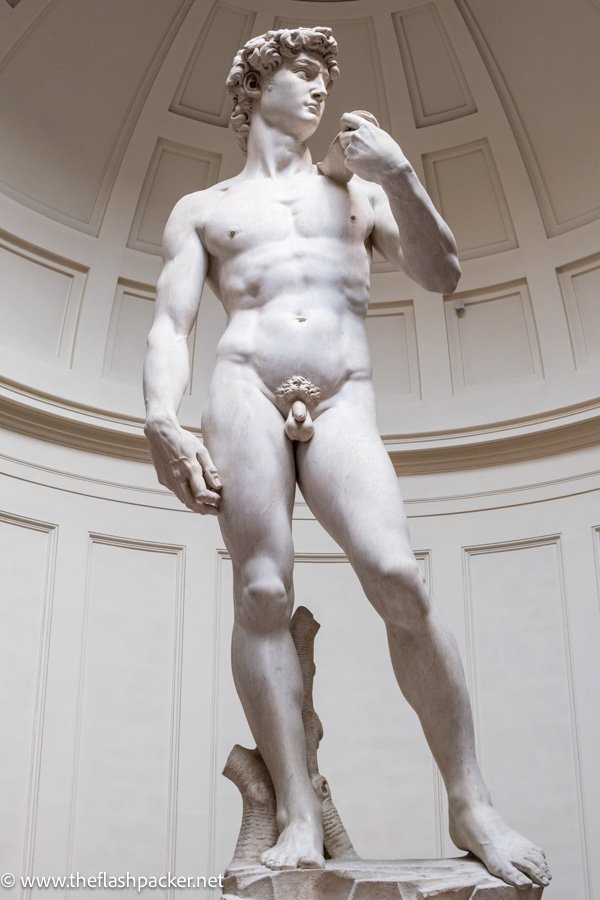
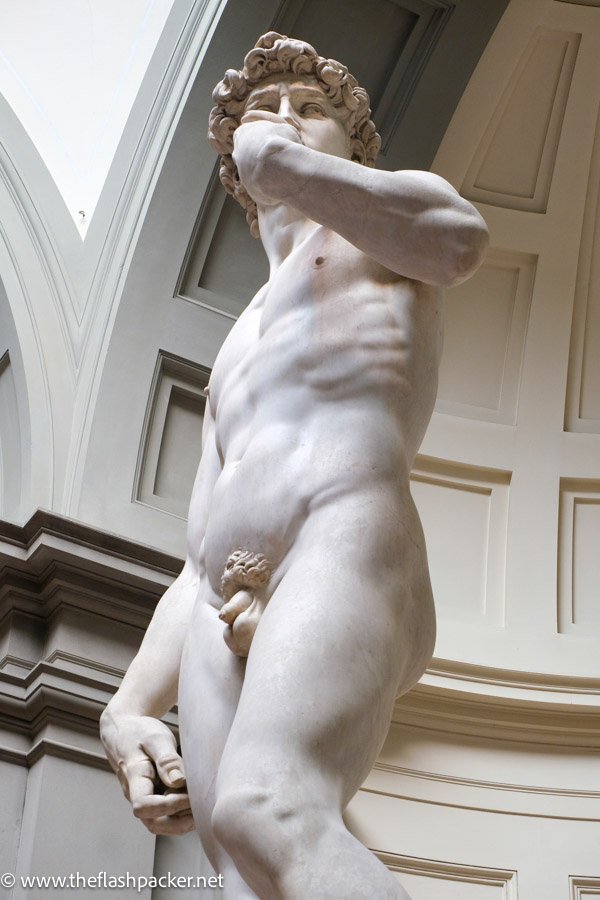
David guarded the entrance to the Palazzo Vecchio for 350 years, after which time he was replaced by a copy and moved to the Accademia. A second copy stands in Piazzale Michelangelo, one of Florence’s best viewpoints.
If you are visiting Galleria Borghese in Rome, compare Michelangelo’s David with that sculpted by Gian Lorenzo Bernini. They are very different.
The Prisoners (Michelangelo Buonarroti)
Created between 1516 and 1534, these unfinished figures look like they are trying to free themselves from the stone.
The Prisoners were designed for the tomb of Pope Julius II. However, this was completed on a smaller scale than planned, minus this sculptural ensemble. You can see the tomb at San Pietro in Vincoli in Rome.
What makes this group of sculptures so intriguing is that they offer insight into Michelangelo’s creative process and his understanding of the human body. The sculptor spent months in the Carrara quarries to select the blocks of the brightest marble available.
There are four prisoners or slaves in total: Bearded Slave, Young Slave, Awakening Slave and Atlas Slave. Here are my two favourites. Michelangelo’s chisel marks are still clearly visible.
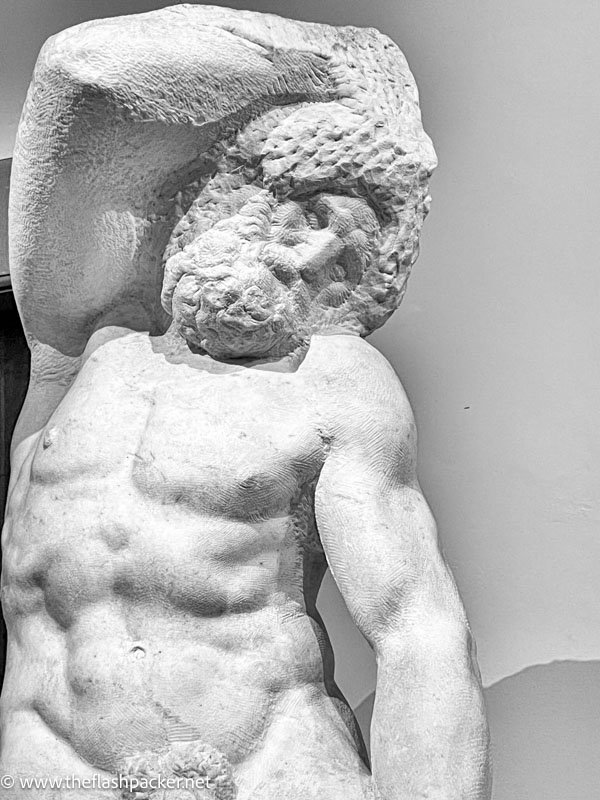
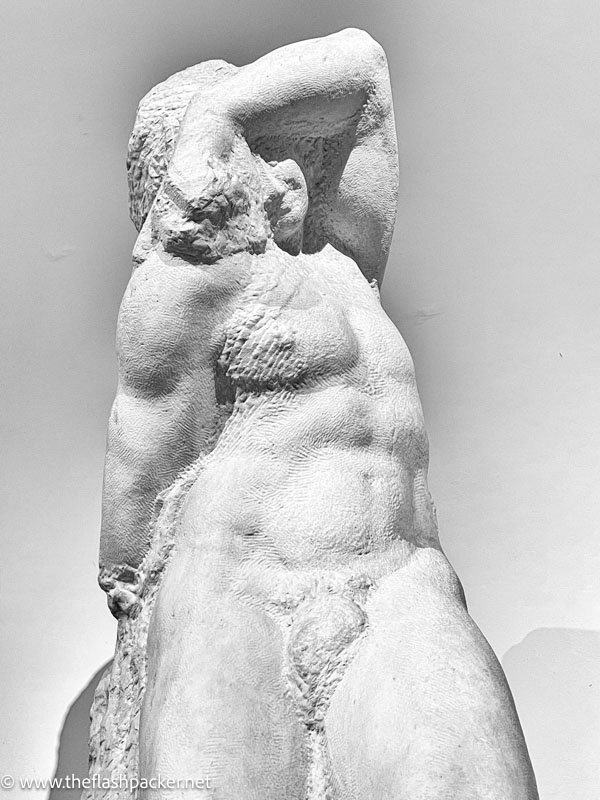
Statues in Florence’s Piazza della Signoria
The copy of Michelangelo’s David is not the only statue in the Piazza della Signoria, one of Florence’s famous landmarks. He is kept company by a clutch of outstanding sculptures, collectively forming Florence’s free outdoor art gallery.
Rape of the Sabine Women (Giambologna)
You’ll find this extraordinarily graphic statue in the Loggia dei Lanzi, to the right of the Palazzo Vecchio. Originally a space where ordinary Florentines could share what was on their mind – think of it as a medieval version of London’s Speakers’ Corner – the loggia was turned into an outdoor sculpture gallery by the Medici.
Giambologna’s 1560 sculpture depicts a Roman soldier stamping on a Sabine man, whilst carrying off his wife. The entwined bodies with their spiralling composition were carved from a single block of marble.
See the look of horror on the Sabine husband’s face.
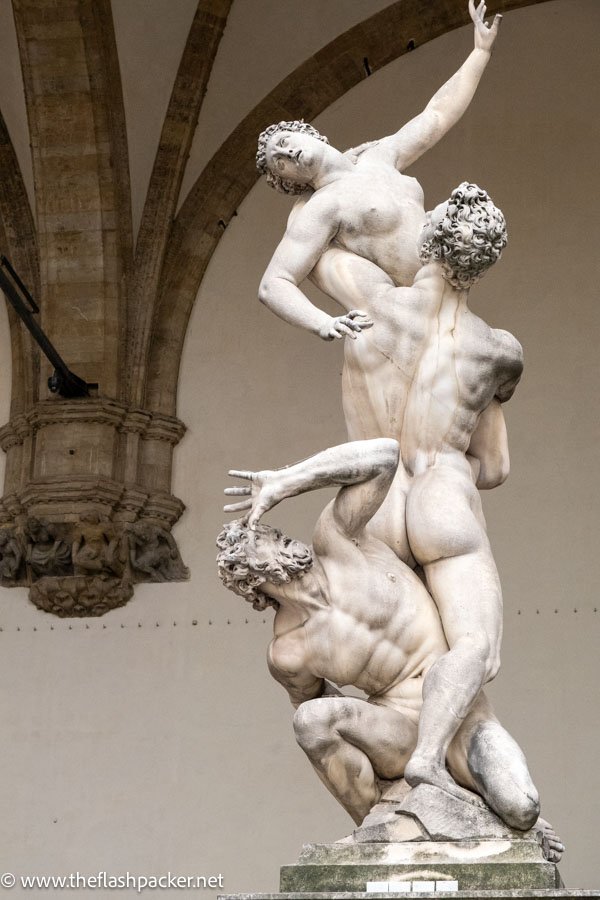
Perseus (Benevenuto Cellini)
In the centre of the Loggia dei Lanzi is Cellini’s dramatic statue of the Greek demi-god Perseus, decapitating the snake-headed Medusa. Sculpted from bronze between 1545 and 1554, the sculpture stands on a square base that depicts the story of Perseus and Andromeda.
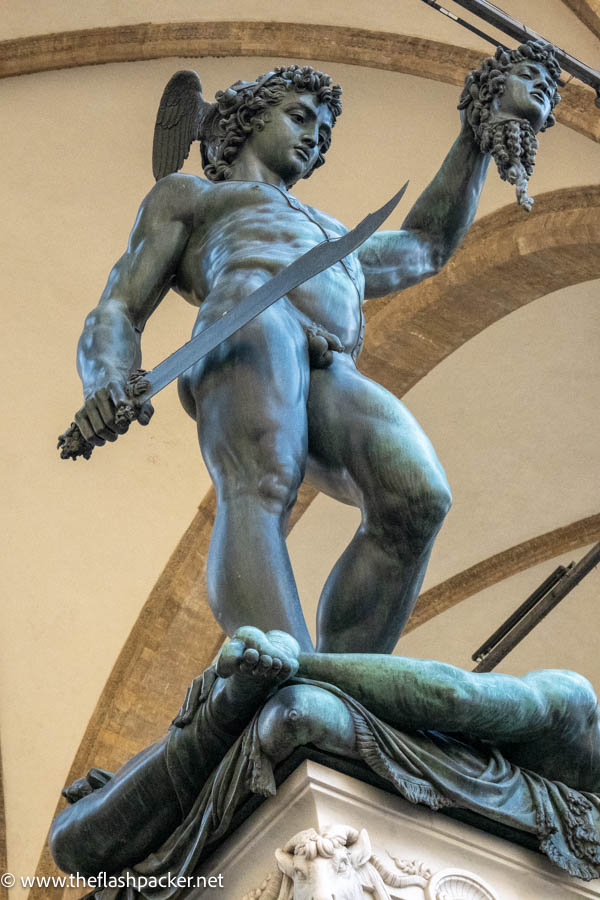
Neptune Fountain (Bartolomeo Ammannati)
Dating from 1575, this famous monument in Florence represents Neptune, the Roman god of the sea, lording it over his entourage of nymphs, tritons and dolphins. Carved from a single block of Carrara marble, the Neptune Fountain symbolised Tuscan victories at sea.
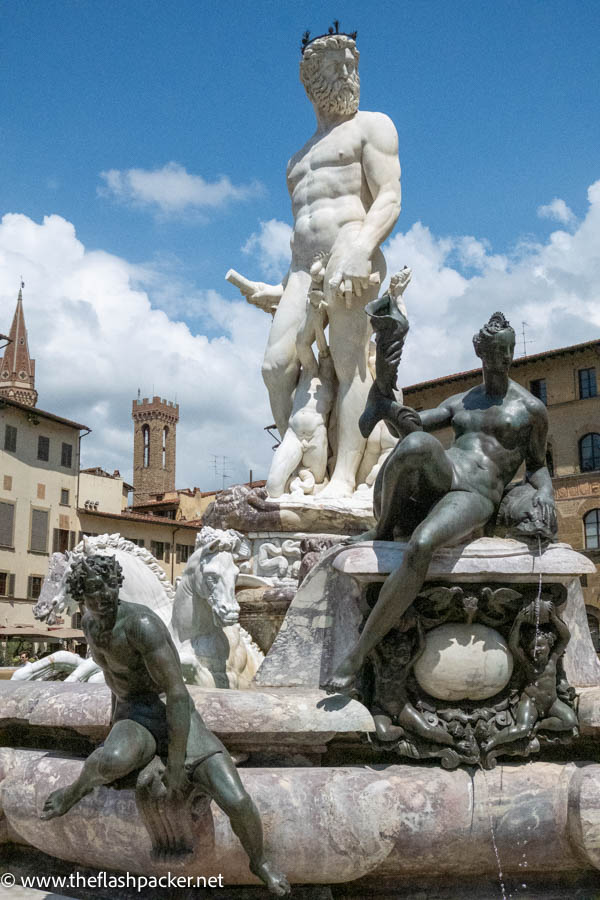
Before you leave Piazza della Signoria, take a last look at the face of Neptune and compare it to that of the neighbouring statue of Cosimo I on horseback by Giambologna. Pretty similar eh?
That’s no accident. Ammannati modelled his sculpture on the face of his wealthy patron.
Sculptures in the Opera del Duomo Museum, Florence
Much like the Bargello Museum, the Opera del Duomo Museum welcomes a fraction of the visitors descending upon Florence’s better-known attractions. Ignore it at your peril.
This haven of tranquillity is home to some of the best sculptures in Florence, as well as Brunelleschi’s model for his magnificent dome and a recreation of the original façade of the cathedral.
Address: Piazza del Duomo 9, Florence
Opening hours: Check here for current opening hours
Entrance fee applies. Choose between three passes that include admission to other monuments of Piazza del Duomo. It is not possible to buy an individual ticket for the Opera del Duomo Museum.
I highly recommend buying your pass in advance.
Mary in Majesty / Maesta / Madonna with Glass Eyes (Arnolfo di Cambio)
When work began on the new cathedral in Florence in 1296, sculpture was the artistic medium of choice to proclaim the city’s modernity and economic strength. Monumental statues graced the main façade of Santa Maria del Fiore but were removed in 1587 when the façade was torn off.
Arnolfo di Cambio’s Maesta, commonly known as Madonna with Glass Eyes, took pride of place in this Renaissance façade. Di Cambio, who also designed Orvieto Cathedral, sculpted her in marble but included glass eyes to make her look more realistic.
I think that they are slightly creepy, but maybe that’s just me.
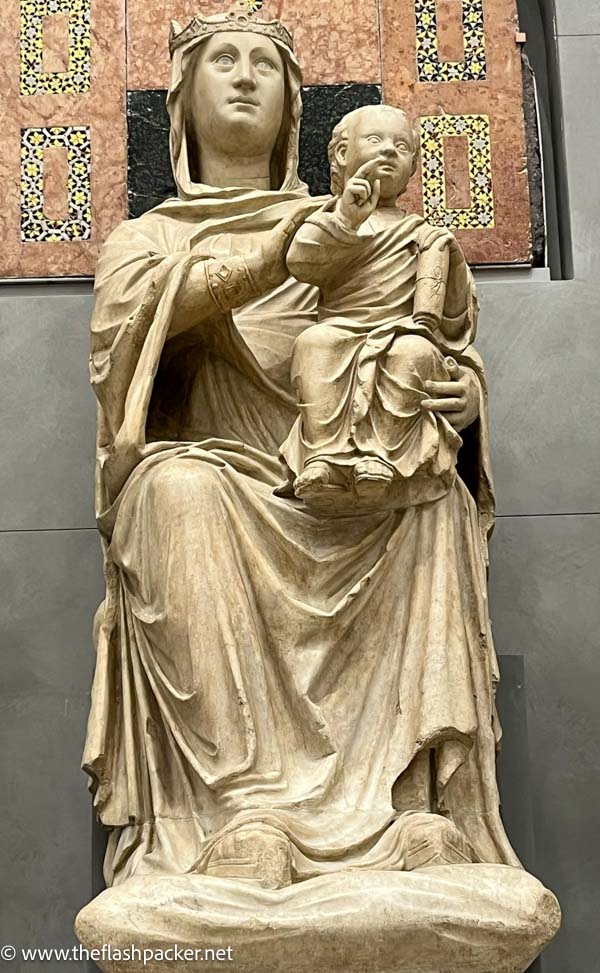
Created around 1300 she would have been at least partially painted.
Gates of Paradise (Lorenzo Ghiberti)
Opposite the recreated façade of Santa Maria del Fiore are Lorenzo Ghiberti’s North and East Doors of the Baptistery.
Created between 1425 and 1452, the East Doors are the stars of this show. Coined “The Gates of Paradise” by none other than Michelangelo, these bronze bas-reliefs changed the way that Renaissance people viewed the world around them.
Ghiberti recalled several Old Testament stories using perspective and realism as never seen before. The depth of perspective and fine detail are extraordinary.
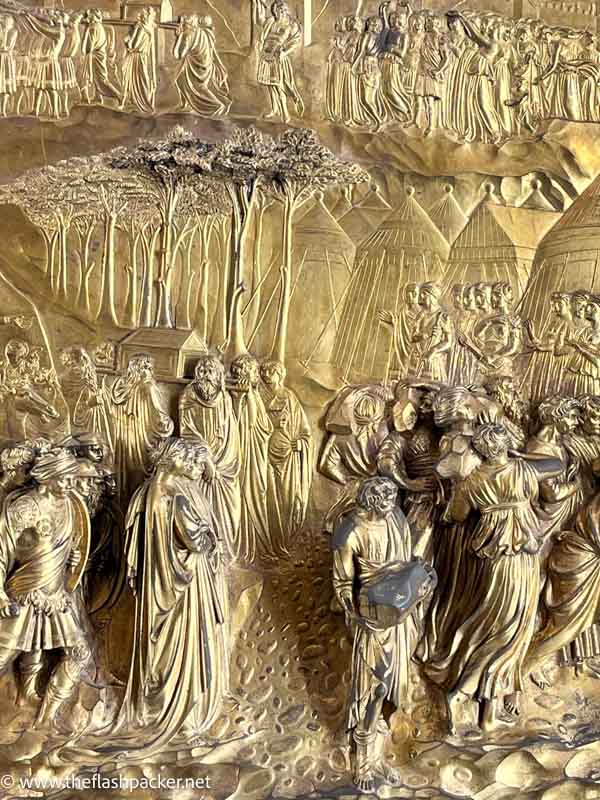
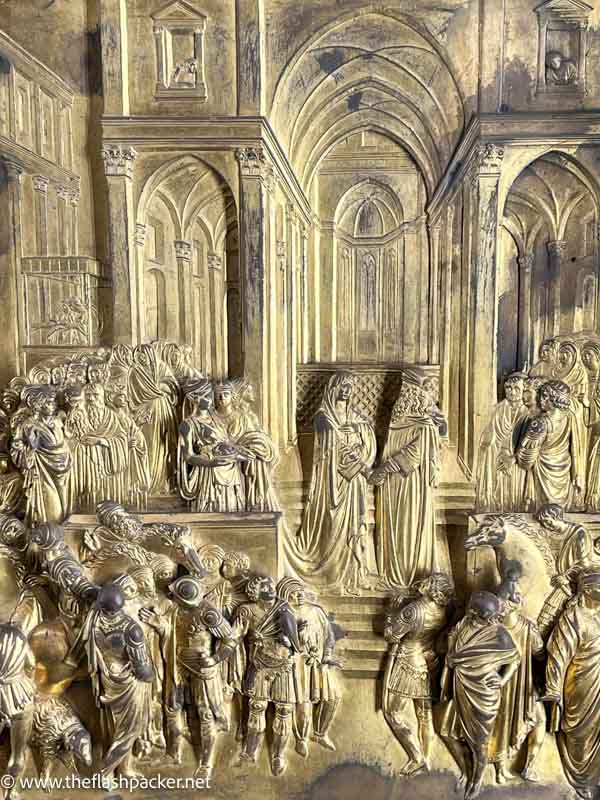
Check out the self-portrait of the artist just to the left of the centre of the door.
If you are not able to visit the Museo Duomo, there are copies of the Gates of Paradise on the doors of the Baptistery facing the Duomo.
Mary Magdalene (Donatello)
It’s rare to see Mary Magdalen depicted in this manner. To me, this sculpture looks strikingly modern.
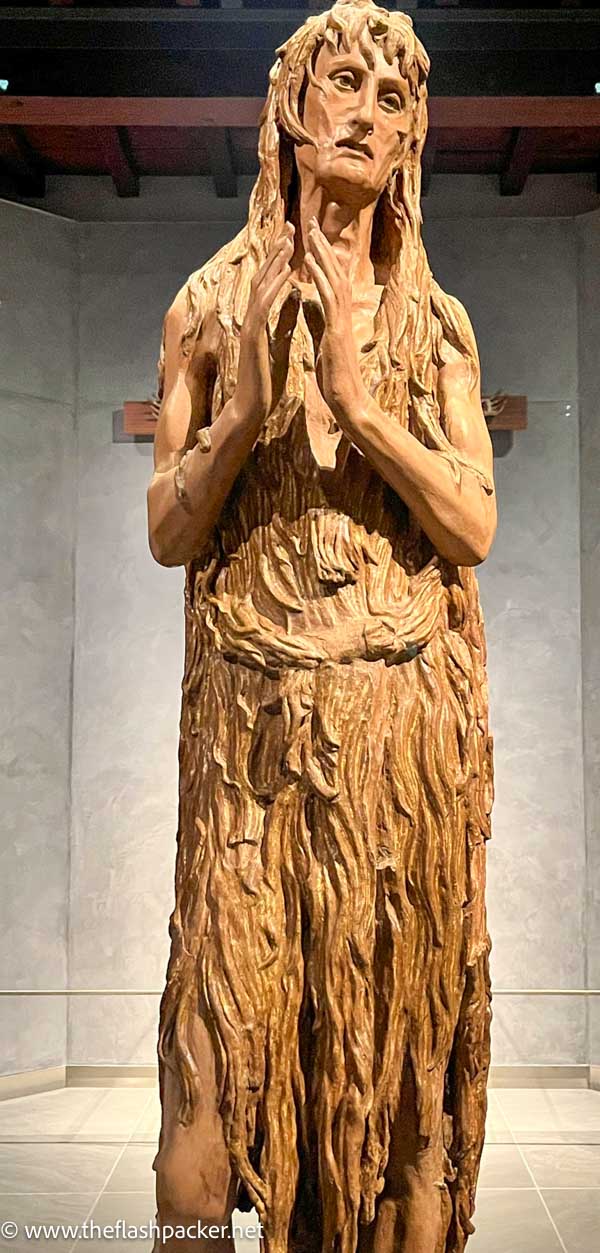
Carved from poplar wood in the mid-1450s, she is emaciated and penitent. The paint from this statue has long since faded.
Florentine Pietà (Michelangelo)
Michelangelo sculpted more than one Pietà in his lifetime. Whilst the most celebrated of these resides in St Peter’s Basilica in Rome, I was moved more by this later Florentine Pietà.
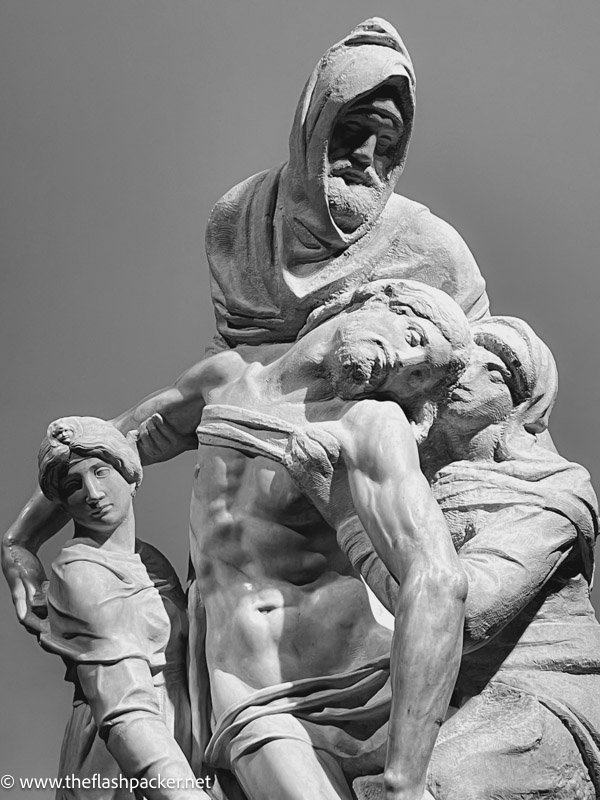
An ageing Michelangelo designed his own tomb with a Pietà at its centre (1547 – 1555). Three mourners tend to the body of a crucified Christ: Mary, Mary Magdalen and Nicodemus, who was a converted Pharisee. The face of Nicodemus is modelled on that of Michelangelo.
Where to See These Sculptures in Florence, Italy
If you find it helpful to map things out, here’s one showing the locations of these famous sculptures in Florence. For an interactive map, simply click here or on the image itself.
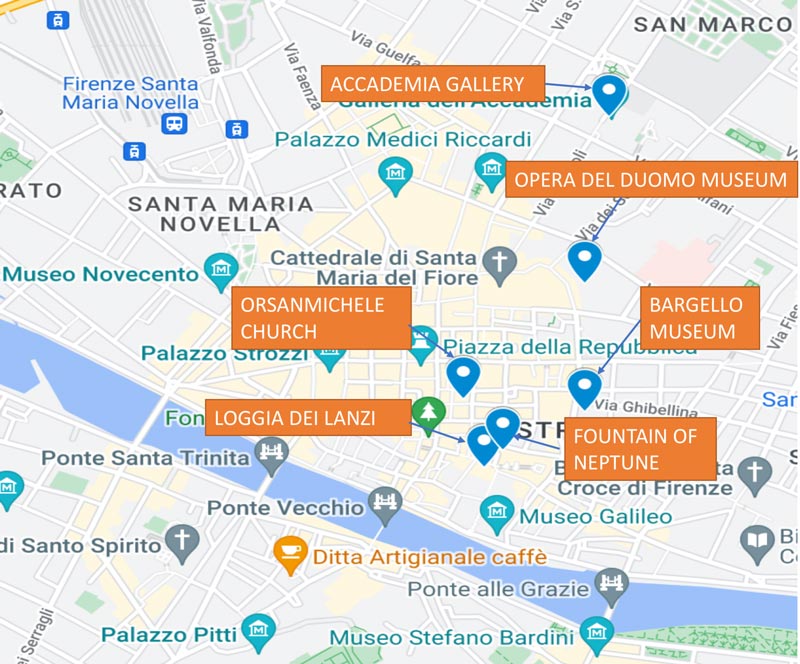
Thank you for reading about my favourite Florence statues
I hope my guide has sparked your curiosity and helps you plan your visit. These sculptures are truly inspirational.
If you have found this helpful, you may enjoy some of my other guides to art in Italy:
- Renaissance Art in Florence: 30 Famous Paintings You Cannot Miss
- 11 Places to Find the Art of Michelangelo in Florence, Italy
- Visiting the Scrovegni Chapel in Padua: Giotto’s Masterpiece
PS. If you’ve found this guide helpful, Pin it to read later!
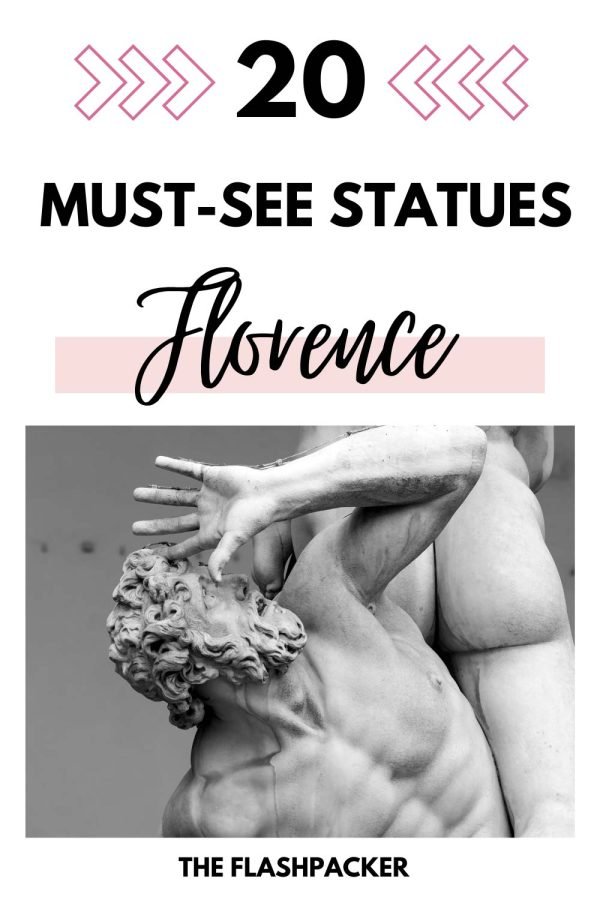
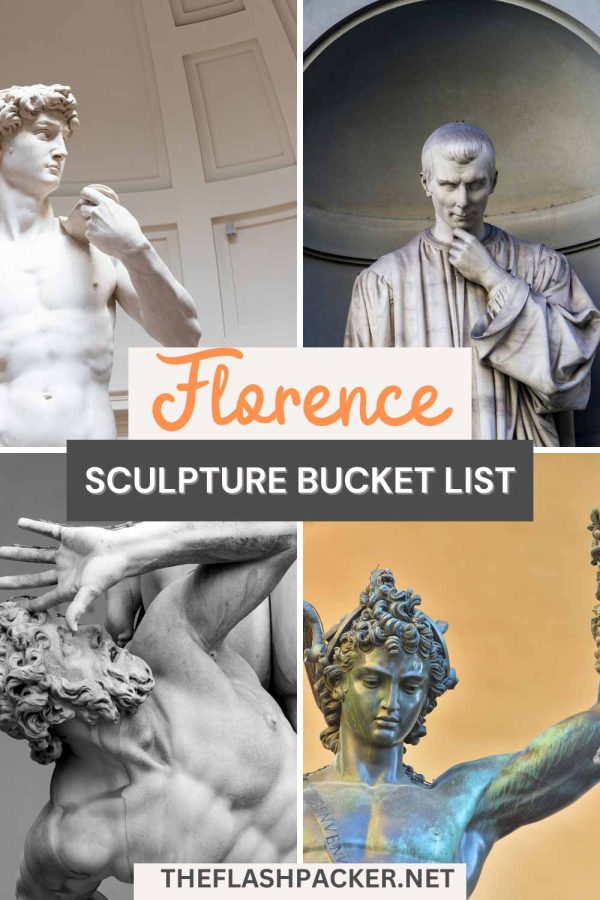

About Bridget
Bridget Coleman is a Renaissance fan girl and has been travelling the globe for more than 30 years. She has visited 70+ countries, most as a solo traveller.
Articles on this site reflect her first-hand experiences.
To get in touch, email her at hello@theflashpacker.net or follow her on social media.

